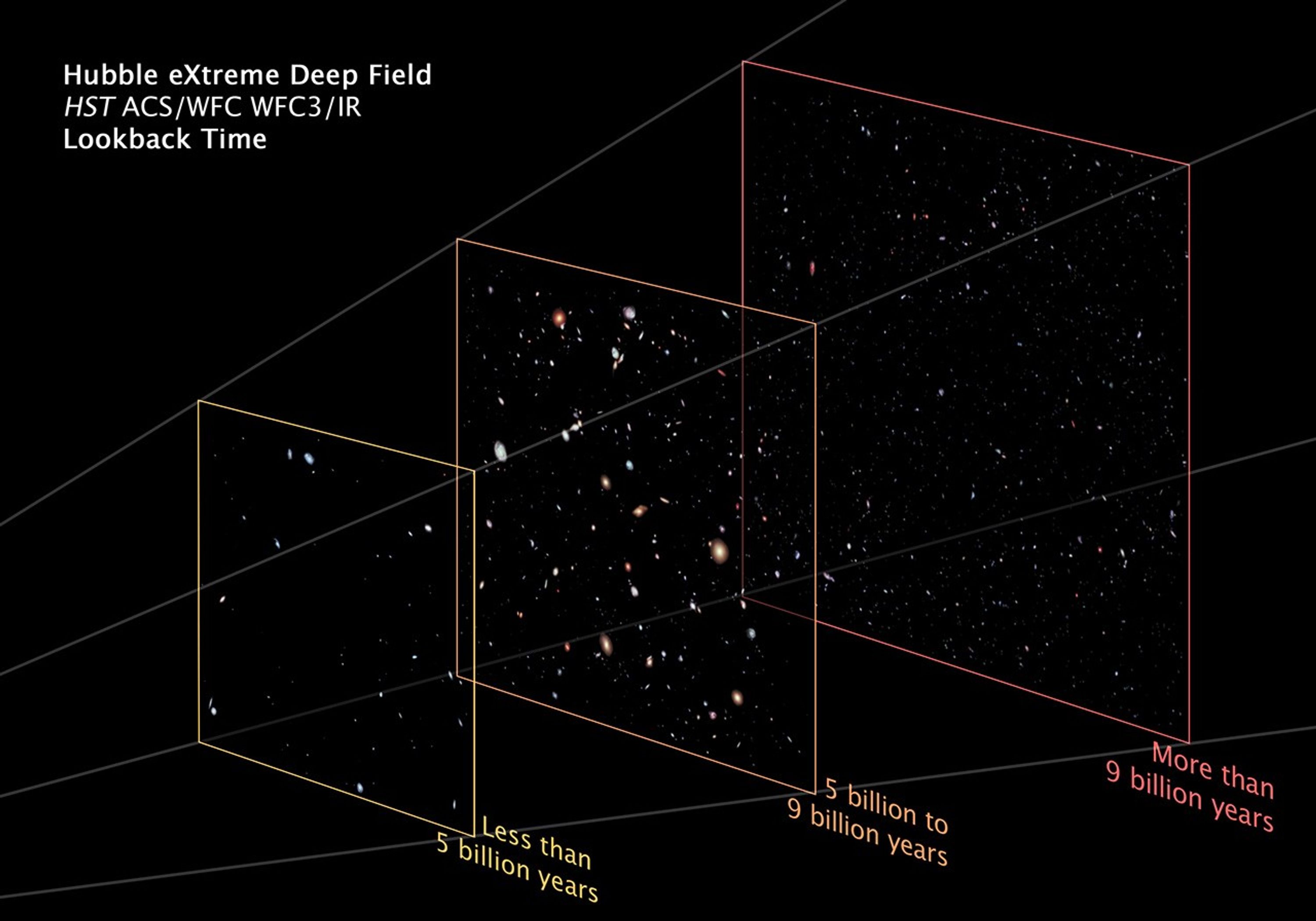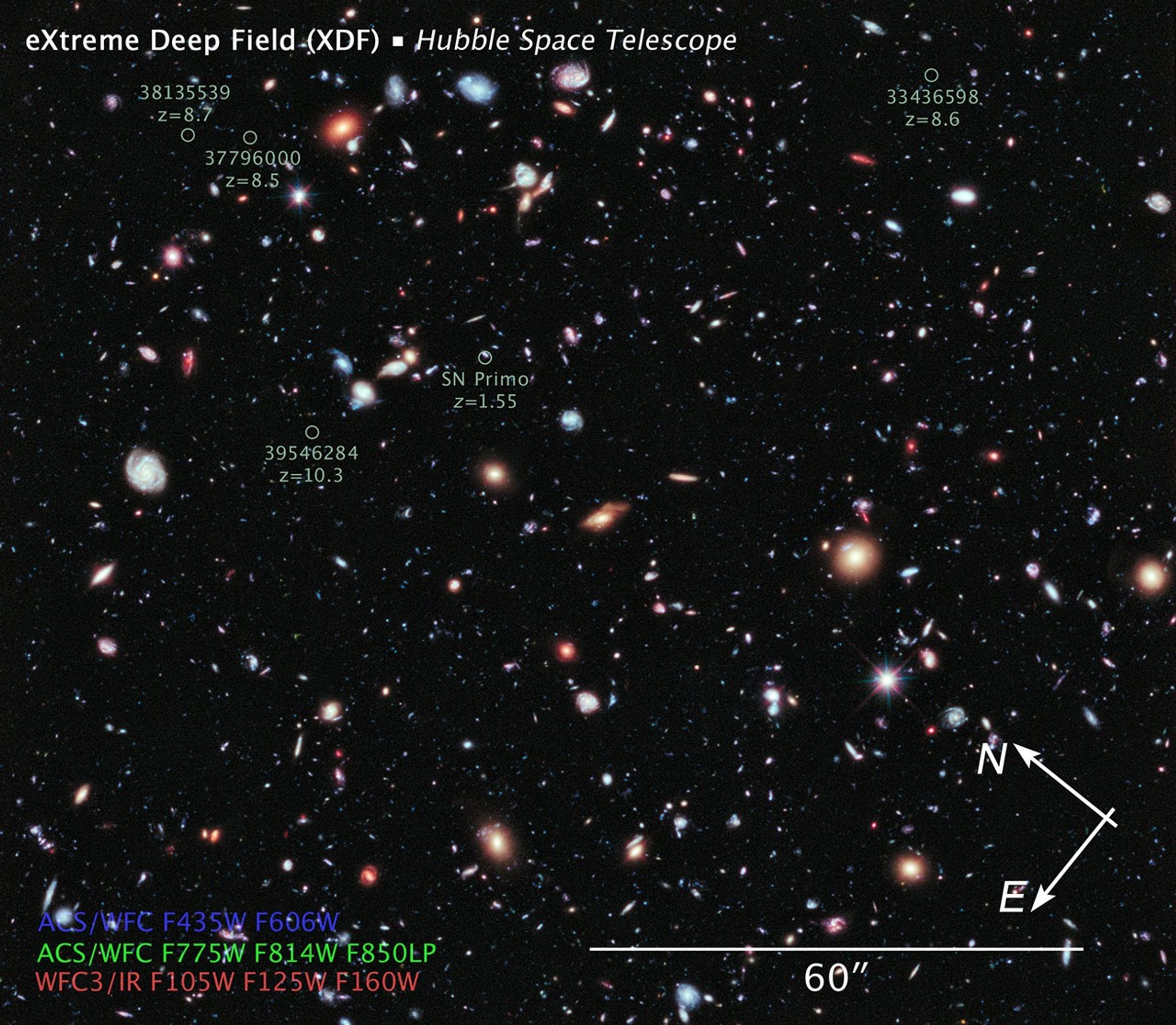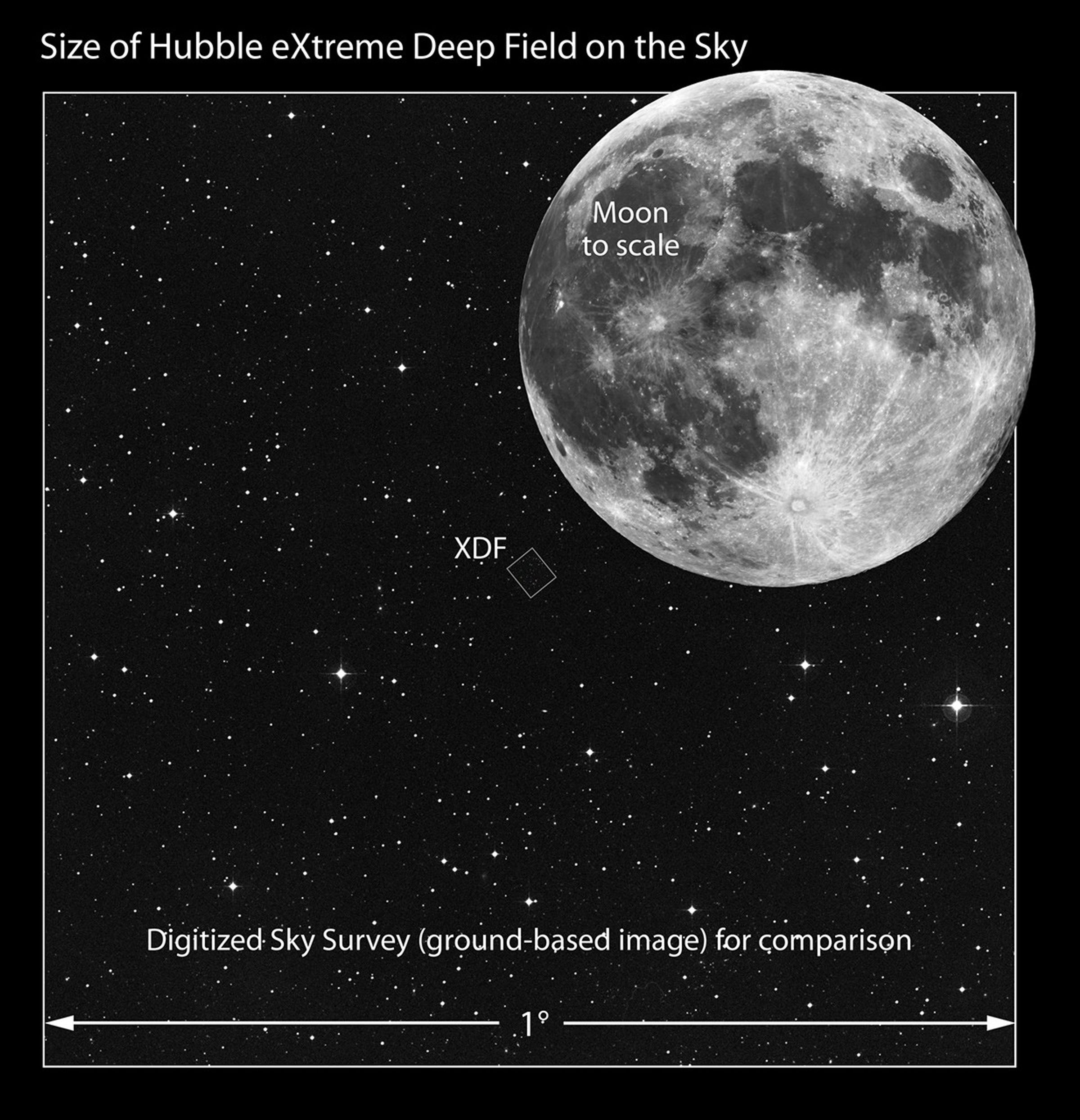1 min read
Hubble eXtreme Deep Field (XDF)

The eXtreme Deep Field, or XDF, was assembled by combining 10 years of NASA Hubble Space Telescope photographs taken of a patch of sky at the center of the original Hubble Ultra Deep Field. The XDF is a small fraction of the angular diameter of the full Moon.
The Hubble Ultra Deep Field is an image of a small area of space in the constellation Fornax, created using Hubble Space Telescope data from 2003 and 2004. By collecting faint light over many hours of observation, it revealed thousands of galaxies, both nearby and very distant, making it the deepest image of the universe ever taken at that time.
The new full-color XDF image reaches much fainter galaxies, and includes very deep exposures in red light from Hubble's new infrared camera, enabling new studies of the earliest galaxies in the universe. The XDF contains about 5,500 galaxies even within its smaller field of view. The faintest galaxies are one ten-billionth the brightness of what the human eye can see.
Magnificent spiral galaxies similar in shape to our Milky Way and the neighboring Andromeda galaxy appear in this image, as do the large, fuzzy red galaxies where the formation of new stars has ceased. These red galaxies are the remnants of dramatic collisions between galaxies and are in their declining years. Peppered across the field are tiny, faint, more distant galaxies that were like the seedlings from which today's striking galaxies grew. The history of galaxies – from soon after the first galaxies were born to the great galaxies of today, like our Milky Way – is laid out in this one remarkable image.
Hubble pointed at a tiny patch of southern sky in repeat visits (made over the past decade) for a total of 50 days, with a total exposure time of 2 million seconds. More than 2,000 images of the same field were taken with Hubble's two premier cameras – the Advanced Camera for Surveys and the Wide Field Camera 3, which extends Hubble's vision into near-infrared light – and combined to make the XDF.
"The XDF is the deepest image of the sky ever obtained and reveals the faintest and most distant galaxies ever seen. XDF allows us to explore further back in time than ever before," said Garth Illingworth of the University of California at Santa Cruz, principal investigator of the Hubble Ultra Deep Field 2009 (HUDF09) program.
The universe is 13.7 billion years old, and the XDF reveals galaxies that span back 13.2 billion years in time. Most of the galaxies in the XDF are seen when they were young, small, and growing, often violently as they collided and merged together. The early universe was a time of dramatic birth for galaxies containing brilliant blue stars extraordinarily brighter than our Sun. The light from those past events is just arriving at Earth now, and so the XDF is a "time tunnel into the distant past." The youngest galaxy found in the XDF existed just 450 million years after the universe's birth in the big bang.
About the Object
- R.A. PositionR.A. PositionRight ascension – analogous to longitude – is one component of an object's position.03h 32m 38.5s
- Dec. PositionDec. PositionDeclination – analogous to latitude – is one component of an object's position.-27° 47' 0.0"
- ConstellationConstellationOne of 88 recognized regions of the celestial sphere in which the object appears.Fornax
- DistanceDistanceThe physical distance from Earth to the astronomical object. Distances within our solar system are usually measured in Astronomical Units (AU). Distances between stars are usually measured in light-years. Interstellar distances can also be measured in parsecs.The image is 2.3 arcminutes by 2 arcminutes in size.
About the Data
- Data DescriptionData DescriptionProposal: A description of the observations, their scientific justification, and the links to the data available in the science archive.
Science Team: The astronomers who planned the observations and analyzed the data. "PI" refers to the Principal Investigator.The image was created from Hubble data from the following proposals: 9352, 10189, 10340, and 12099: A. Riess (STScI/JHU); 9425: M. Giavalsco (University of Massachusetts); 9488: K. Ratnatunga (Carnegie Mellon University); 9575: W. Sparks (STScI); 9793 and 10530: S. Malhotra (Arizona State University); 9978 and 10086: S. Beckwith (STScI); 10258: C. Kretchmer (JHU); 11359: R. O'Connell (University of Virginia); 11563: G. Illingworth (University of California, Santa Cruz); 12060 - 12062: S. Faber (University of California, Santa Cruz); 12177: P. van Dokkum (Yale University). The XDF/HUDF09 team members include: G. Illingworth (University of California, Santa Cruz), R. Bouwens (Leiden University), M. Carollo (Swiss Federal Institute of Technology, Zurich (ETH)), M. Franx (Leiden University), V. Gonzalez (University of California, Santa Cruz), I. Labbe (Leiden University), D. Magee and P. Oesch (University of California, Santa Cruz), M. Stiavelli (STScI), M. Trenti (University of Cambridge), and P. van Dokkum (Yale University). - InstrumentInstrumentThe science instrument used to produce the data.HST>ACS/WFC and HST>WFC3/IR
- Exposure DatesExposure DatesThe date(s) that the telescope made its observations and the total exposure time.July 2002 to March 2012, Exposure Time: 22.5 days (2 million seconds)
- FiltersFiltersThe camera filters that were used in the science observations.ACS/WFC: F435W (B), F606W (V), F775W (I), F814W (I), and F850LP (z) WFC3/IR: F105W (Y), F125W (J), and F160W (H)
- Object NameObject NameA name or catalog number that astronomers use to identify an astronomical object.Hubble eXtreme Deep Field, XDF
- Object DescriptionObject DescriptionThe type of astronomical object.Optical and Infrared Survey
- Release DateSeptember 25, 2012
- Science ReleaseHubble Goes to the eXtreme to Assemble Farthest Ever View of the Universe
- Credit

This image is a composite of separate exposures acquired by the ACS and WFC3/IR instruments. Several filters were used to sample various wavelengths. The color results from assigning different hues (colors) to each monochromatic (grayscale) image from the eight different filters used by the two instruments grouped as follows: Blue: ACS/WFC F435W (B) + F606W (V) Green: ACS/WFC F775W (I) + F814W (I) + F850LP (z) Red: WFC3/IR F105W (Y) + F125W (J) + F160W (H)

Related Images & Videos

Looking Back into Time With the XDF
This illustration separates the XDF into three planes showing foreground, background, and very far background galaxies. These divisions reflect different epochs in the evolving universe. Fully mature galaxies are in the foreground plane that shows galaxies as they looked less...

Hubble eXtreme Deep Field Pushes Back Frontiers of Time and Space
This video explains how astronomers meticulously assembled mankind's deepest view of the universe from combining Hubble Space Telescope exposures taken over the past decade. Guest scientists are Dr. Garth Illingworth and Dr. Marc Postman.

Flight Through the Hubble eXtreme Deep Field (2D Zoom and 3D Fly-Through Sequence)
This video begins with a zoom into the small area of sky that the Hubble Space Telescope observed to construct the eXtreme Deep Field, or XDF. The region is located in the southern sky, far away from the glare of the Milky Way, the bright plane of our galaxy. In terms of angular...

Flight Through the Hubble eXtreme Deep Field
This scientific visualization depicts a flight through the galaxies in the Hubble eXtreme Deep Field (XDF). Using measured and estimated distances for approximately three thousand galaxies, astronomers and visualizers constructed a three-dimensional model of the XDF galaxy...

Meet the Hubble eXtreme Deep Field Observing Team (Webinar on September 27, 2012)
A new, improved portrait of Hubble's deepest-ever view of the universe, called the eXtreme Deep Field, or XDF, looks far away and back in time to reveal faint galaxies at one ten-billionth the brightness of what the human eye can see. This is the culmination of 10 years of...
Share
Details
Claire Andreoli
NASA’s Goddard Space Flight Center
Greenbelt, Maryland
claire.andreoli@nasa.gov

































